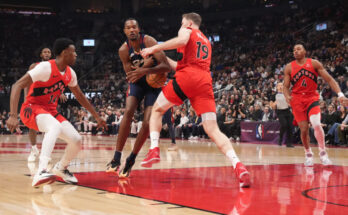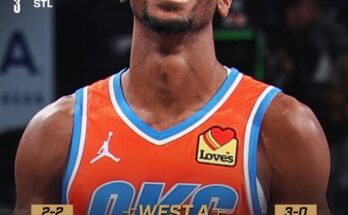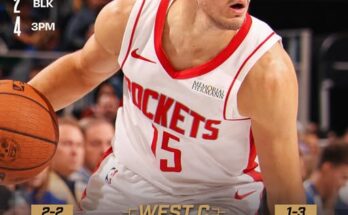Jordan Poole’s return to the Golden State Warriors in a blockbuster three-team trade has shaken up the NBA landscape, marking a significant shift in team dynamics and roster composition for all parties involved. The trade, which sees the Washington Wizards acquiring Buddy Hield and Kevon Looney, not only impacts the Warriors’ backcourt and frontcourt rotation but also reshapes the Wizards’ roster in a way that could influence their future direction. This deal, centered around Poole’s much-anticipated homecoming, highlights the intricate nature of NBA trades where talent, contracts, team needs, and long-term strategies intersect.
Jordan Poole initially made his mark with the Warriors as an exciting, young guard with tremendous scoring ability and a flair for making clutch plays. His development from a promising rookie into a key contributor was crucial in Golden State’s backcourt, especially after the departure of some veteran players and the evolving roles of stars like Stephen Curry, Klay Thompson, and Draymond Green. Poole’s offensive creativity, ability to penetrate defenses, and three-point shooting prowess added a dynamic edge to the Warriors’ offense, making him a valuable asset in their championship-contending formula.
The decision for Golden State to reacquire Poole in this three-team trade underscores their belief in his potential and fit within their system. After his initial years with the Warriors, Poole had stints with other teams, but the Warriors evidently see this as an opportunity to bring back a familiar and proven talent who can complement their core stars. This move suggests the Warriors are focusing on bolstering their guard rotation with a player who already understands their playing style and culture. It is a strategic attempt to enhance offensive versatility and backcourt depth, which could be pivotal in their quest for more championships.
Meanwhile, the Washington Wizards, in receiving Buddy Hield and Kevon Looney, are addressing their immediate needs with experienced and reliable players. Buddy Hield, known for his sharpshooting and ability to spread the floor, offers the Wizards a much-needed boost in perimeter scoring. His reputation as one of the league’s more consistent three-point shooters makes him an ideal fit for a team looking to improve offensive spacing and efficiency. Hield’s presence on the wing can open driving lanes for guards and provide a reliable catch-and-shoot option in crucial moments.
Kevon Looney’s inclusion in the trade offers the Wizards an experienced frontcourt presence who excels in rebounding, defense, and setting screens. Looney, a veteran of multiple championship runs with the Warriors, brings toughness and versatility to the center and power forward positions. His ability to anchor the paint defensively and his high basketball IQ make him a valuable piece for any team seeking to improve its interior defense and rebounding. Looney’s steady, unselfish style of play complements the more offensively focused players on the Wizards’ roster and provides balance to their lineup.
For the Warriors, the departure of Buddy Hield and Kevon Looney may seem like a sacrifice, but it is a calculated one. The Warriors are known for building around their core of Curry, Thompson, and Green, supplemented by young talents and shooters who fit their motion offense. Bringing back Poole reinforces their backcourt depth and gives them an additional weapon capable of creating offense both off the dribble and in catch-and-shoot situations. Poole’s familiarity with the Warriors’ system reduces the adjustment period and ensures he can contribute meaningfully from the outset.
This trade also reveals a broader strategy by Golden State to maintain flexibility and balance on their roster. By swapping Hield and Looney for Poole, the Warriors are reshaping their rotation in a way that maximizes their offensive firepower while maintaining enough depth to weather injuries and heavy minutes in a long NBA season. The Warriors’ front office is likely confident that other players on the roster can step up defensively and on the boards to compensate for Looney’s departure. Moreover, Hield’s exit, while impactful, is mitigated by Poole’s ability to create his own shot and facilitate offense.
From the Wizards’ perspective, acquiring Hield and Looney signals a commitment to improving specific aspects of their team. Washington has been searching for consistent perimeter shooting and reliable interior defense to support their core players. Hield’s shooting prowess directly addresses the former, while Looney’s rebounding and defensive skills cover the latter. This move could also indicate a shift towards a more balanced and competitive roster as the Wizards seek to build around their stars and improve their standing in a competitive Eastern Conference.
The trade will inevitably alter the chemistry and playing style of both teams. The Warriors will likely incorporate Poole more heavily in their offensive schemes, taking advantage of his scoring bursts and ability to relieve pressure from Curry and Thompson. Poole’s knack for making highlight plays and energizing the crowd fits well with Golden State’s high-paced, ball-movement-driven offense. On defense, however, the Warriors may face challenges in replacing Looney’s role, as his defensive acumen and rebounding were key components of their championship formula. It will be interesting to see how the coaching staff adjusts their rotations and defensive strategies to accommodate these roster changes.
For the Wizards, integrating Hield and Looney will require adjustments, but their veteran experience should facilitate a smoother transition. Hield’s off-ball movement and quick release can open up offensive sets, while Looney’s physicality inside adds toughness to the paint. These attributes might help the Wizards close gaps in their lineup and offer more options on both ends of the floor. The challenge for Washington will be blending these new pieces with their existing roster and maximizing their impact without disrupting team chemistry.
The ripple effects of this trade extend beyond the immediate roster changes. Trades of this magnitude often influence future draft strategies, salary cap considerations, and potential subsequent moves. The Warriors may leverage the financial and roster flexibility gained through this trade to pursue other targets in free agency or the trade market. Meanwhile, the Wizards could view this deal as a foundation for further retooling or as a step towards a more competitive lineup that can contend in the Eastern Conference.
Moreover, the psychological and motivational aspects should not be underestimated. Poole’s return to Golden State might reignite his passion and confidence, fueled by familiar surroundings and strong fan support. Players often perform better when they feel valued and connected to their team’s culture, and Poole’s previous success with the Warriors suggests this reunion could be beneficial for both player and franchise. On the other hand, Hield and Looney will bring fresh energy and a winning mentality to the Wizards, potentially boosting morale and raising the team’s competitive spirit.
In the broader NBA context, this trade exemplifies the ongoing trend of teams looking to optimize their rosters by balancing star power, role players, and financial considerations. It highlights how franchises are constantly evaluating talent fit, team chemistry, and strategic needs, willing to make bold moves to gain a competitive edge. The involvement of three teams adds complexity but also allows for more creative solutions that can benefit all parties involved.
Overall, the trade sending Jordan Poole back to the Golden State Warriors while the Washington Wizards receive Buddy Hield and Kevon Looney is a landmark transaction with significant implications. It reshapes the Warriors’ backcourt, adding a dynamic scorer and playmaker familiar with their system, while giving the Wizards veteran shooters and defensive presence to improve their lineup balance. The success of this trade will ultimately depend on how well each team integrates its new players and adjusts its strategies to maximize the collective strengths of their roster. For fans and analysts alike, this trade provides plenty to watch as the NBA season progresses, with the potential to alter the trajectory of both franchises in meaningful ways.



